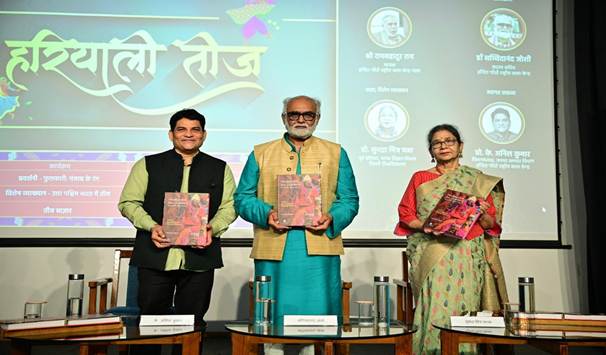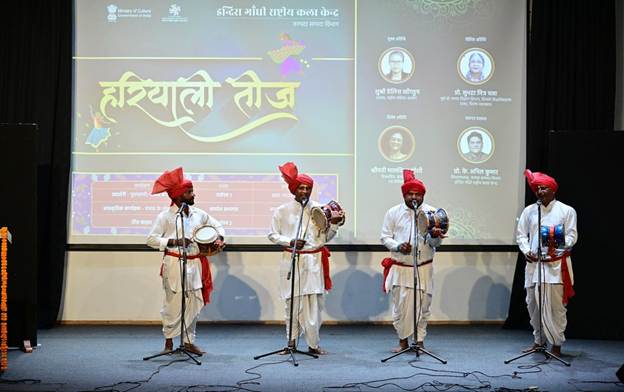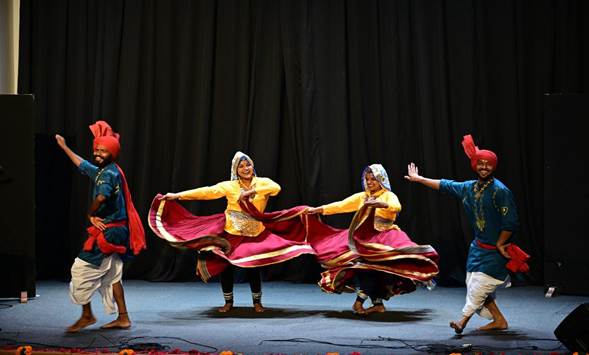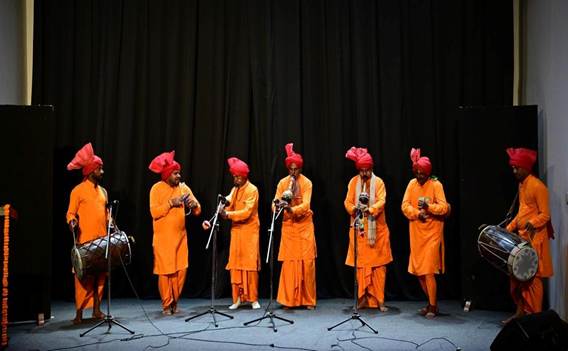“Hariyali Teej Symbolises Familial Unity and Cultural Continuity”: Dr. Sachchidanand Joshi
“Hariyali Teej Symbolises Familial Unity and Cultural Continuity”: Dr. Sachchidanand Joshi
The Janapada Sampada Division of the Indira Gandhi National Centre for the Arts (IGNCA), under the Ministry of Culture, Government of India, observed its Foundation Day on the occasion of the festival ‘Hariyali Teej’ at its New Delhi campus. Marking the onset of the monsoon with vibrant traditions and artistic expression, the celebration featured a range of engaging programmes including exhibitions, folk performances, and a festive bazaar that reflected the rich cultural heritage of Punjab. A special Teej Bazaar was set up as part of the festivities, offering a diverse selection of handicrafts and traditional attire. Stalls showcased indigenous produce from across the country. Stalls featured local delicacies, handmade crafts, and organic produce from various states, ranging from Punjab to Andhra Pradesh. A dedicated mehndi (henna) stall was also arranged for the women employees of IGNCA, adding to the festive spirit. The celebration sought to revive and spotlight regional traditions associated with this seasonal festival, encouraging cultural continuity and community participation. The exhibition titled ‘Phulkari: Punjab ke Rang’ and the cultural presentation ‘Punjab ke Lok Nritya’ were among the highlights of the day, offering immersive glimpses into Punjab’s vibrant aesthetic and performing traditions.

The occasion was graced by Ms. Delina Khongdup, Member, National Commission for Women, as the Chief Guest. Prof. Subhadra Mitra Channa, Former Professor, Department of Anthropology, University of Delhi, attended as the Distinguished Guest, while Smt. Malvika Joshi, noted educationist, storyteller, and writer, was the Guest of Honour. The session was chaired by Dr. Sachchidanand Joshi, Member Secretary, IGNCA. The programme commenced with a welcome address by Prof. K. Anil Kumar, Head of the Janapada Sampada Division, IGNCA. This was followed by a presentation of the division’s annual report by Dr. Rembemo Odyuo, who elaborated on the division’s work, initiatives, and achievements over the past year.

During his address, Dr. Sachchidanand Joshi remarked that ‘Hariyali Teej’ stands as a symbol of familial unity. Recalling the legend associated with the festival, he noted that Goddess Parvati observed fasts 108 times to attain Lord Shiva as her spouse, an act emphasizing the deep significance of commitment and togetherness in family life. In the context of contemporary society, where familial bonds and relationships are increasingly fragile and strained, such festivals serve as vital cultural anchors that keep us emotionally and socially connected. Dr. Joshi further emphasised that family and environment are intrinsically linked, and festivals like Teej teach us to remain rooted in these connections, helping us grow from strength to strength. Highlighting the academic vision of IGNCA, he added that even within scholarly pursuits, one division of the institution often undertakes the scale and depth of work that many entire institutions do not attempt-reflecting IGNCA’s commitment to both cultural and intellectual richness.

Prof. Subhadra Mitr Channa, former Professor of Anthropology at the University of Delhi, highlighted the deeper cosmological and social significance of Teej, noting that such festivals are often overlooked in academic spaces despite their rich symbolic value. She explained that the festival marks the symbolic union of Shiva and Parvati, representing the cosmic balance between purusha (passive, stabilising energy) and prakriti (dynamic, creative energy). Celebrated during the monsoon, ‘Hariyali Teej’ reflects themes of regeneration and fertility, yet also serves as a reminder of the need for balance-since unrestrained energy can be destructive. She further observed that festivals like Teej transcend their ritualistic role, serving as markers of time and continuity in societies without dependence on modern calendars. In rural areas, people often reference life events in relation to such festivals, indicating their enduring practical and cultural relevance.

Ms. Delina Khongdup shared that it was a delightful experience to witness the country’s diverse and vibrant culture. While ‘Teej’ is not celebrated in Meghalaya, she referred to the ‘Behdienkhlam’ festival observed during ‘Saavan’; as a reflection of the continuity of Indian traditions. Emphasising the need for gender equality, she urged men to be equal partners and called for collective efforts to challenge biases against women. She also stressed the importance of remaining vigilant against crimes and violations of women’s rights. Smt. Malvika Joshi congratulated the Janapada Sampada Division for curating vibrant stalls and a thoughtfully designed exhibition. She reiterated the enduring continuity of festivals across India, celebrating their cultural depth. Concluding her address, she captivated the audience with a soulful rendition of “Kaare Badra Re, Tu Tou Julm Kiya –Ek Tou Kaari Raat, duje Piya Pardesh,” evoking the emotion and spirit of the season.
The celebrations concluded with a vibrant cultural performance presented by the ‘Ranga Ranga Art Cultural Association’, offering a spirited finale to the day’s festivities. The performance featured lively folk music and dance from Punjab and Haryana, beautifully capturing the rhythm, colour, and energy of the region’s seasonal traditions.
****
Sunil Kumar Tiwari